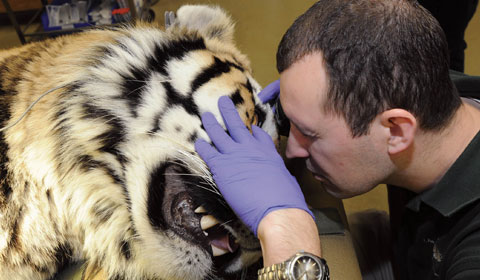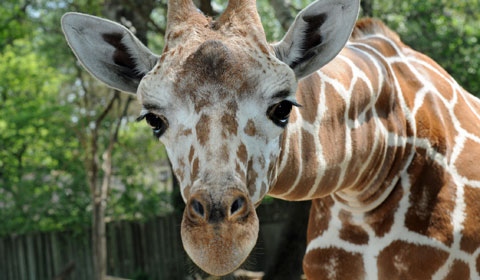News Release
Contact: Sondra Katzen, Public Relations, 708.688.8351, sondra.katzen@czs.org
November 22, 2016
FOR IMMEDIATE RELEASE
Note: Images of the Amur leopard may be downloaded below.
Amur Leopard Cub_1
Amur Leopard Cub_2
Amur Leopard Cub_3
Amur Leopard Cub_4
Amur Leopard Cub_5
Amur Leopard Cub Makes Public Debut at Brookfield Zoo
Brookfield, Ill. – A 4-month-old male Amur leopard cub made his public debut today and can be seen in his outdoor habitat at Brookfield Zoo’s Big Cats, weather permitting. Since his birth on July 22, the now 20-pound cub, named Temur (prounced Tee-moor), has been behind the scenes bonding with his mom, Lisa.
Animal care staff introduced Lisa, 5, and the sire, Kasha, 6, to one another in 2015 and witnessed breeding in April of this year. For the past four months, staff have been monitoring the cub to ensure that he is healthy and meeting crucial developmental milestones.
Lisa is from Saint Louis Zoological Park, while Kasha is from Le Parc des Felins in France. Both leopards arrived at Brookfield Zoo in 2013 as part of the Association of Zoos and Aquariums’ Amur Leopard Species Survival Plan (SSP). An SSP is a cooperative population management and conservation program for select species in accredited North American zoos and aquariums. Each plan manages the breeding of a species to maintain a healthy and self-sustaining population that is both genetically diverse and demographically stable.
The Amur leopard is a critically endangered species with fewer than 70 animals left in the wild. In May 2013, the World Association of Zoos and Aquariums (WAZA) convened an Amur Leopard Global Species Management Plan (GSMP). The GSMP involves four regional zoo associations: AZA in North America, the European Association of Zoos and Aquaria (EAZA) in Europe, the Japanese Association of Zoos and Aquariums in Japan, and the Eurasian Regional Association of Zoos and Aquariums (EARAZA) in the Eurasian region representing the native range of this subspecies. As of 2013, 92 institutions hold 210 Amur leopards derived from 13 founders and representing 89 percent gene diversity.
The biggest threats to these solitary animals are poaching; retribution hunting; a decrease in their habitat from fires, logging, and human settlement; and a decline in their prey. This birth marks a crucial addition to the population and will help raise awareness about the importance of conservation and the threats this species faces in the wild.
“To be able to add to the population of a species so rare in the wild is an incredible opportunity to better understand the animals and educate the public on ways to help protect the species,” said Bill Zeigler, senior vice president of animal programs for the Chicago Zoological Society, which manages Brookfield Zoo. “The birth demonstrates a successful collaboration among institutions, including internationally effective care for this critically endangered species.”
Amur leopards, known for their keen senses of hearing, vision, and smell, are a nocturnal species native to temperate forests with cold winters and hot summers. The animals live in southwestern Russia, typically resting in trees and dense vegetation or among the rocks during the day. Amur leopards are the northernmost subspecies of leopard in the world and are often mistaken for snow leopards.
Temur is one of the Chicago Zoological Society’s Share the Care featured animals this holiday season. Those interested in helping care for him can contribute to the program. Several options are available. For $35, a recipient will receive the Basic Package, which includes a 5-inch x 7-inch color photograph of Temur, a personalized adoption certificate, a fact sheet about the species, a Share the Care car decal, and an invitation to the 2017 Share the Care Evening. The $55 Plush Package includes all the benefits of the Basic Package plus a 12-inch plush leopard. Finally, the $80 Deluxe Package includes the benefits of the Basic and Plush packages, as well as four free tickets to Share the Care Evening in 2017 and a Brookfield Zoo navy cotton canvas tote. For further information, visit CZS.org/SharetheCare.
# # #
About the Chicago Zoological Society
The mission of the Chicago Zoological Society is to inspire conservation leadership by connecting people with wildlife and nature. The Chicago Zoological Society is a private nonprofit organization that operates Brookfield Zoo on land owned by the Forest Preserves of Cook County. The Society is known throughout the world for its international role in animal population management and wildlife conservation. Its Center for the Science of Animal Care and Welfare is at the forefront of animal care that strives to discover and implement innovative approaches to zoo animal management. Brookfield Zoo is the first zoo in the world to be awarded the Humane Certified™ certification mark for the care and welfare of its animals, meeting American Humane Association’s rigorous certification standards. Open every day of the year, the zoo is located off First Avenue between the Stevenson (I-55) and Eisenhower (I-290) expressways and is also accessible via the Tri-State Tollway (I-294), Metra commuter line, CTA, and PACE bus service. For further information, visit CZS.org.
MEDIA CONTACT:
Sondra Katzen
Director of Public Relations
Office: 708-688-8351
Cell Phone: 708-903-2071
E-mail: Sondra.Katzen@CZS.org

Read about our innovative practices in animal welfare to ensure the ultimate care of our individual animals.

Create extraordinary connections with animals and nature!

Become our partner in caring for animals and in connecting people with wildlife and nature.